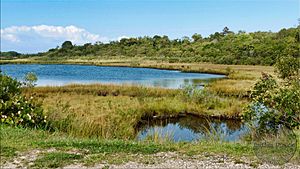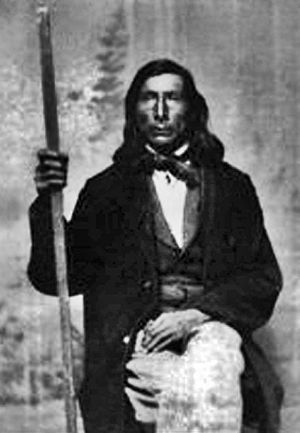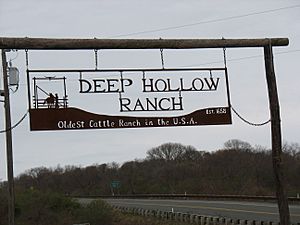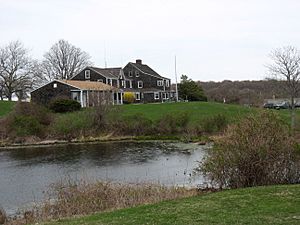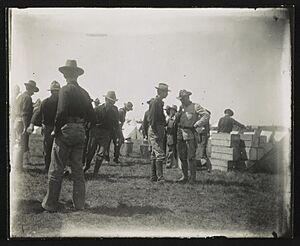Montauk County Park facts for kids
Quick facts for kids Montauk County Park |
|
|---|---|
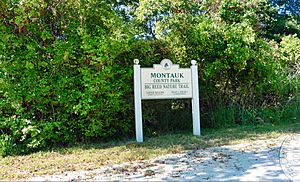
Montauk County Park
|
|
| Lua error in Module:Location_map at line 420: attempt to index field 'wikibase' (a nil value). | |
| Type | Regional park |
| Location | Montauk, New York, U.S. |
| Area | 1,157 acres (4.68 km2) |
| Operated by | Suffolk County Department of Parks, Recreation & Conservation |
Montauk County Park is a large park located about 3 miles (5 km) east of Montauk, New York. It covers 1,157 acres (468 hectares) of land. The park stretches from Montauk Highway north to Block Island Sound. It is next to Montauk Point State Park on its eastern side.
This park was created between 1971 and 1986. Suffolk County bought the land with help from Hilda Lindley and local citizens. The park was first named Theodore Roosevelt County Park in 1998. This was to celebrate 100 years since Theodore Roosevelt returned to Long Island after the Spanish–American War. However, in 2014, its name was changed back to "Montauk County Park." This happened because Roosevelt's connection to the area was not very strong.
The park has many interesting places to explore:
- Big Reed Pond – a special natural area.
- Montaukett Village – an old home and burial ground of the Montaukett Native American tribe. It includes the grave of Stephen Talkhouse.
- Deep Hollow Ranch – the first cattle ranch in the United States, started in 1658.
- Third House – a historic building from the 1700s. It was built for people who looked after cattle.
- Camp Wikoff – where Theodore Roosevelt and his Rough Riders stayed after the Spanish–American War.
Contents
Big Reed Pond: A Special Natural Place
Big Reed Pond became a registered National Natural Landmark in 1973. This means it is a very important natural area. The pond has a mix of fresh water and slightly salty water (brackish water). Some wetlands around it are brackish.
The sandy soil and lots of rain in the area create a delicate balance. This balance keeps the fresh water and saltwater separate. Keeping the County Park as open space helps protect this special natural balance.
Montaukett Village: History of the First People
The Montaukett tribe of Native Americans lived in this area of Long Island for a very long time. In the late 1600s, Chief Wyandanch gave a large part of Long Island's South Fork to Lion Gardiner. The remaining Montaukett people continued to live here.
Later, in 1879, Arthur Bensen bought the Montauk peninsula. You can still see the ruins of a sweat lodge and parts of the old village. The Pharaoh Museum is in a small cabin near Third House. It shows tools and pottery used by the Montaukett people. Stephen Talkhouse, a famous Montaukett member, is buried in the cemetery. He was known for his long walks, sometimes 30 to 50 miles (48 to 80 km) in a day. These walks inspired the Paumanok Path.
Deep Hollow Ranch: Birthplace of the Cowboy
Deep Hollow Ranch says it is where the American cowboy began. It started as a cattle ranch in 1658. It has been running ever since! Today, you can enjoy horseback riding and hay rides there.
From 1990 to 1999, the ranch hosted "Back at the Ranch" concerts. These events raised money for local charities. Singer–songwriter Paul Simon, who lives nearby, helped with many of these concerts. Famous musicians played there, including The Allman Brothers Band, James Brown, Jimmy Buffett, Billy Joel, and James Taylor. Sometimes, as many as 10,000 people came to each show.
Third House: A Historic Cattle Keeper's Home
Third House was one of the first homes built on the eastern tip of Long Island. It was built in the 1700s, after the Montauk Point Lighthouse keeper's quarters. There were also First House and Second House. These houses were for the cattle keepers. They brought horses, sheep, and cattle to graze in Montauk every year. This happened from May through November.
In the summers, up to 6,000 cattle, horses, and sheep roamed the pastures. They came from places as far west as Patchogue, which is about 70 miles (113 km) away.
First House is no longer standing. Second House is now a museum in Montauk village. Third House is used as the main office for Deep Hollow Ranch. In 1879, Arthur Bensen bought most of the land from Napeague to Montauk Point. He wanted to develop the area into a summer resort. He made Third House his home.
Camp Wikoff: A Military History Site
Arthur Bensen's plans for a resort did not fully happen. He sold much of the land to the U.S. government. The government used it for Army, Navy, and later Air Force bases.
Camp Wikoff was built on 5,000 acres (2,023 hectares) of land. It was used to keep 29,000 soldiers separate from others. This included Theodore Roosevelt and the Rough Riders. They were quarantined after the Spanish–American War in 1898. This was to stop the spread of diseases like yellow fever. The camp was named after Col. Charles A. Wikoff, who died in the war.
During World War II, parts of Camp Wikoff were used for large gun positions and concrete bunkers. These were part of New York's coastal defense. In the Cold War, a big radar tower was built at the Camp Hero section. Later, the military left the camp. It was then divided into three state parks:
- Camp Hero State Park
- Montauk Point State Park
- Shadmoor State Park
Other parts of the camp were sold to private owners. Third House, which was once Camp Wikoff's headquarters, is now the park's main office. It has an exhibit about the Spanish–American War. You can see photos and items from the war and learn about Roosevelt's Rough Riders. Camp Wikoff is open to visitors from May through October.
See also
- Hendrick van der Heul
- Hilda Lindley House


